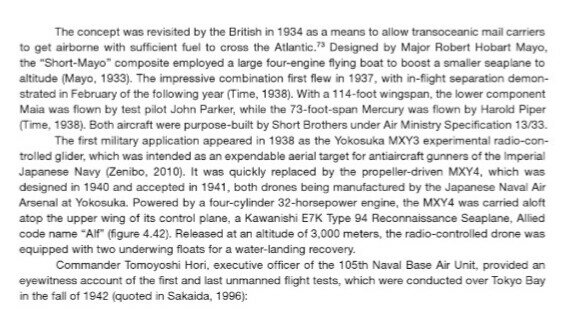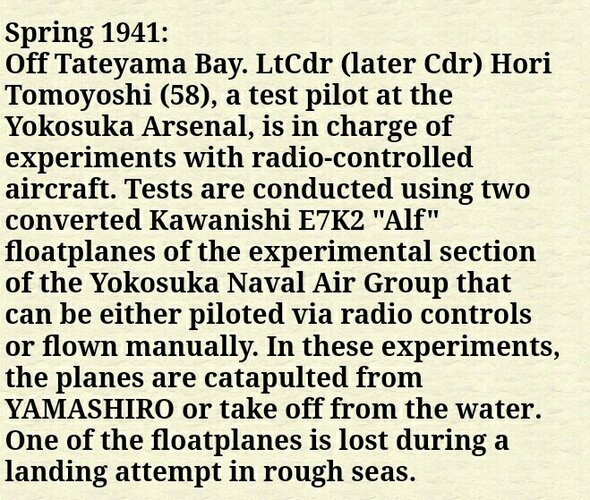You are using an out of date browser. It may not display this or other websites correctly.
You should upgrade or use an alternative browser.
You should upgrade or use an alternative browser.
Yokosuka (Kugisho) MXY4 Type 1 Target Plane
- Thread starter hesham
- Start date
- Joined
- 25 June 2009
- Messages
- 14,107
- Reaction score
- 4,239
A great Japanese website shows two wonderful scale models of the MXY4 Type 1 Target Plane:
http://www.ne.jp/asahi/tsmc/net/work-21.html
http://www.ne.jp/asahi/tsmc/net/work-22.html
http://www.ne.jp/asahi/tsmc/net/work-21.html
http://www.ne.jp/asahi/tsmc/net/work-22.html
Attachments
blackkite
Don't laugh, don't cry, don't even curse, but.....
- Joined
- 31 May 2007
- Messages
- 8,574
- Reaction score
- 6,764
Attachments
Hafidz Rahman
Just an Aeroweebs...
Hi!
Based on H. R. Everett's Book, Unmanned Systems of World Wars I and II and Combine Fleet Website:
The concept was introduce in 1938 as aerial target for IJN's antiaircraft gunners, but replace with propelled driven MXY4 in 1940 & 1941.
*In spring 1941, LtCdr. Hori Tomoyoshi (later Cdr.), a test pilot of Yokosuka Arsenal & executive officer of the 105th Naval Base Air Unit, was in charge of MXY4 experiments. Tests are conducted using two converted Kawanishi E7K2 "Alf" floatplanes of the experimental section of the Yokosuka Naval Air Group that can be either piloted via radio controls or flown manually. In these experiments, the planes are catapulted from YAMASHIRO or take off from the water.
The first prototye (no.1) MXY4 was crashed because the engine failed after the launched. It was the first drone accident for Japan. The second prototype (no. 2), was launched succesfully and flight around the mouth of Tokyo Bay about 30 minutes before turned back and water landing near Yamashiro.
*Noted:
There are two different sources about MXY4 first flight. In Combined Fleet it was qouted, "spring 1941" based on IJN Yamashiro Tubular Records of Movement (TROM). But in Everett's book it quoted, "fall 1942" based on the book The Siege of Rabbaul wrote by Henry Sakaida.
http://www.combinedfleet.com/Yamashiro.htm
https://books.google.co.id/books?id=fNjgCgAAQBAJ&pg=PA310&lpg=PA310&dq=h.+r.+everett+MXY4&source=bl&ots=OrVClQ0cO-&sig=ACfU3U1u9j-lBXXlRHnOz2B3AI1_6vohhQ&hl=en&sa=X&ved=2ahUKEwj5w77g1Nv0AhWMyjgGHZcZBmUQ6AF6BAgbEAI#v=onepage&q=h. r. everett MXY4&f=false




Based on H. R. Everett's Book, Unmanned Systems of World Wars I and II and Combine Fleet Website:
The concept was introduce in 1938 as aerial target for IJN's antiaircraft gunners, but replace with propelled driven MXY4 in 1940 & 1941.
*In spring 1941, LtCdr. Hori Tomoyoshi (later Cdr.), a test pilot of Yokosuka Arsenal & executive officer of the 105th Naval Base Air Unit, was in charge of MXY4 experiments. Tests are conducted using two converted Kawanishi E7K2 "Alf" floatplanes of the experimental section of the Yokosuka Naval Air Group that can be either piloted via radio controls or flown manually. In these experiments, the planes are catapulted from YAMASHIRO or take off from the water.
The first prototye (no.1) MXY4 was crashed because the engine failed after the launched. It was the first drone accident for Japan. The second prototype (no. 2), was launched succesfully and flight around the mouth of Tokyo Bay about 30 minutes before turned back and water landing near Yamashiro.
*Noted:
There are two different sources about MXY4 first flight. In Combined Fleet it was qouted, "spring 1941" based on IJN Yamashiro Tubular Records of Movement (TROM). But in Everett's book it quoted, "fall 1942" based on the book The Siege of Rabbaul wrote by Henry Sakaida.
http://www.combinedfleet.com/Yamashiro.htm
https://books.google.co.id/books?id=fNjgCgAAQBAJ&pg=PA310&lpg=PA310&dq=h.+r.+everett+MXY4&source=bl&ots=OrVClQ0cO-&sig=ACfU3U1u9j-lBXXlRHnOz2B3AI1_6vohhQ&hl=en&sa=X&ved=2ahUKEwj5w77g1Nv0AhWMyjgGHZcZBmUQ6AF6BAgbEAI#v=onepage&q=h. r. everett MXY4&f=false




Hafidz Rahman
Just an Aeroweebs...
Wikipedia Japan has some great articles about Yokosuka MXY3/MXY4 and their control systems depictions:
https://ja.wikipedia.org/wiki/完全自動操縦装置_(日本海軍)
https://ja.wikipedia.org/wiki/一式標的機
https://ja.wikipedia.org/wiki/滑空標的機
In Japan they are called, Set Target Aircraft or Set Target Machine (一式標的機/Isshiki Hyokiki) for MXY4 and Glider Target Aircraft (滑空標的機/Kakku Hyoteki-ki) for MXY3. They are remotely controlled by the M-1 and M-2 radio control devices during flight. For the recovery there are two systems, the float and the parachute systems.
There are some various plans about MXY4 besides the target drones, such as self-destruction attacks within enemy aircraft formations, unmanned lightning strikes, unmanned test flights of new aircraft, and operation as target aircraft and decoy aircraft.
https://ja.wikipedia.org/wiki/完全自動操縦装置_(日本海軍)
https://ja.wikipedia.org/wiki/一式標的機
https://ja.wikipedia.org/wiki/滑空標的機
In Japan they are called, Set Target Aircraft or Set Target Machine (一式標的機/Isshiki Hyokiki) for MXY4 and Glider Target Aircraft (滑空標的機/Kakku Hyoteki-ki) for MXY3. They are remotely controlled by the M-1 and M-2 radio control devices during flight. For the recovery there are two systems, the float and the parachute systems.
There are some various plans about MXY4 besides the target drones, such as self-destruction attacks within enemy aircraft formations, unmanned lightning strikes, unmanned test flights of new aircraft, and operation as target aircraft and decoy aircraft.
windswords
ACCESS: Secret
- Joined
- 19 May 2009
- Messages
- 388
- Reaction score
- 201
"...I don't know they look like a Mistal aircraft projects."
Yes they do, but the important difference is in the Mistal setup the aircraft on the top is the one with the pilot and the bottom is unmanned. Here it is the opposite.
Yes they do, but the important difference is in the Mistal setup the aircraft on the top is the one with the pilot and the bottom is unmanned. Here it is the opposite.
Similar threads
-
Yokosuka (Yokosho/Yosho, Kugisho/Kusho) related topics on this forum
- Started by Stargazer
- Replies: 0
-
-
Yokosuka (Kugisho) MXY1 & MXY2 Experimental Test Planes
- Started by javierarg
- Replies: 10
-
-












